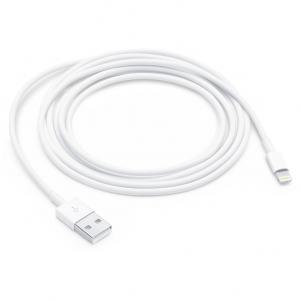Protecting your iPhone charger from damage will save you money and stress.

- Maintaining the integrity of your iPhone charger will help ensure you can safely charge your iPhone with it for longer.
- Tightly wrapping your iPhone charging cable is among several reasons it breaks down faster.
- Avoiding contact with table edges, exposure to liquids and more can help prevent wearing down the rubber protecting the wires inside your charging cable.
An iPhone charger is essential to have on hand, and replacing one is a pain (and can be expensive.) There are a few simple tips to follow when it comes to prolonging your iPhone charger’s life.
iPhone chargers have two parts: a power adapter and a lightening to USB cable. The power adapter is the brick that converts the current from your power outlet from AC to DC, and the lightening cable connects the adapter to the iPhone.

Over time, power adapters can overheat, which can cause internal damage. Simultaneously, any section of your charging cable can wear away and expose the wires inside.
How to care for your iPhone charger and charging cable
Maintaining your iPhone charger’s integrity will help ensure you can safely charge your iPhone with it. Here are seven ways to do it.
1) Always unplug by the head
Don’t pull your charging cable out by grabbing the wire somewhere in the middle, as this puts a lot more stress on the cable. Instead, grab the hard plastic at either end of the cable when unplugging it.
2. Avoid tightly wrapping your iPhone’ charging cable
While it may be tempting to wrap your iPhone’s lightening cable in a tight pattern to keep it organized, doing so can shorten the life of your charger. This practice puts repetitive stress on the thin copper conductors inside charging cables and can cause them to break.
To avoid this, loop your iPhone charging cable loosely to avoid crimping the wires and if you can wrap it a different way each time to avoid repetitive stress on the same section.
3. Use a power strip
Consider a power strip to avoid any electrical damage to your iPhone’s power adapter. But not just any power strip––make sure it has a built-in surge protector. In addition to offering convenience (allowing you to plug in multiple devices with only one outlet), power strips with surge protectors can protect your iPhone, computer, and other electronic devices from power surges that can damage your device.
4. Ensure the adapter has room to breathe
The power adapter can get hot during the charging process. To avoid overheating while your iPhone is charging, make sure it’s placed somewhere with plenty of airflows (e.g., not wedged in a couch cushion), especially if you know you’ll be plugged in for an extended period.

5. Avoid contact with sharp edges
Exposed wires are a big no-no, and extended contact with sharp surfaces like table edges can wear away the rubber protecting the wires in your iPhone charging cable.
Whether you often move your charging cable from one place to another or have a designated charging hub, ensure your setup doesn’t expose these delicate wires to sharp edges.
6. Keep your charging cable away from water
Water and electronic devices don’t mix, so it’s essential to avoid situations where your iPhone charging cable could be accidentally exposed to water as this can cause electrocution, damage to your iPhone, or both. This means not charging your iPhone in or near your kitchen or bathroom.
If your iPhone charger comes into contact with water, disconnect it from the outlet at once and move it away. Thoroughly dry the charger and make sure it is completely dry before deciding whether to use it again.
7. Use different cables to avoid overuse during transport or storage
Of course, this means you’ll have a backup when one breaks down. But opting to have two in your possession is about more than being proactive. It can help reduce the wear and tear of both — and will likely improve their life span.
Reserve a cable specifically for travel, and leave your other charger in your living room or bedroom. Only use the travel cable while you’re on-the-go and the living or bedroom cable while you’re working in the house and in those rooms.
This will help you avoid pulling, stretching, and wrapping your cables as frequently.
